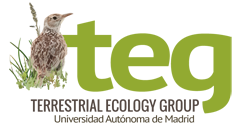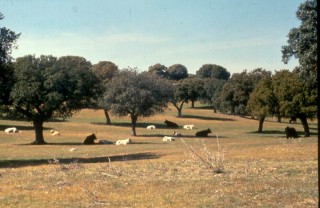Grassland ecology
This line of research has continued uninterrupted since 1980. Its aim is to understanding the functional mechanisms of the vegetation in these species-rich communities, and their response to environmental gradients and changes in land use. The main issues we address are briefly described below:
Livestock affect species colonization-extinction dynamics, and ultimately determine the diversity of grassland communities. Our group was a pioneer in the study of the dual grazing intensification-abandonment process and its effects on the diversity, structure and dynamics of Mediterranean grasslands. We have several lines of work:
- Description of the effects of grazing abandonment on species diversity and soil traits. This line includes the design of individual stocking density models based on topography, vegetation structure and features or barriers related to livestock herd movement.
- Description of the effects of livestock action (defoliation, trampling, faeces) on grassland dynamics through experimentation. We focus on the different responses of species favoured and disadvantaged by grazing in the case of defoliation, the quantity and quality of ground level light and livestock dung leachates and their interaction with soil pathogens.
- Quantification of the relevance of herbivore endo- and exozoochory for seed bank input, germination success and survival and establishment of seedlings. We have found that endozoochory influences pasture diversity through the input of new species. We have also documented long-distance exozoochorous seed dispersal and population fragmentation in abandoned areas due to the lack of dispersal.
- Quantification of the role of ants in grassland and shrub vegetation dynamics. We have looked at some of the mechanisms involved in invasion by Lavandula stoechas and Cytisus scoparius, the two dominant shrub species in our zone.
- The influence of herbivores on the regeneration niche, with a particular focus on seed morphological and function traits that influence their survival and germination after passage through the herbivore gut, their persistence in the seed bank and the depth at which the seeds in the bank can germinate.
- Effects of the abandonment of long and short-distance seasonal transhumance, including changes in long-distance seed dispersal, the influence of drove roads on biodiversity and the effects of transhumance abandonment on tree regeneration in dehesas (open woodlands).
Altitudinal gradients and the effect of rainfall and productivity on plant community dynamics
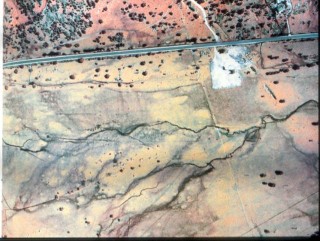 Mediterranean climates have high inter-annual rainfall variations, which causes major fluctuations in productivity. Seed banks are very important due to the abundance of annual species in these systems, so the study of the vegetation and the seed banks in relation to water availability helps us to understanding the dynamics of these systems. Other factors such as variations in productivity due to more stable topographic and climatic differences, which can be observed by studying altitudinal gradients, also affect these dynamics. All these factors cause major space-time variations in the composition and diversity of Mediterranean grasslands. Our group has addressed the influence of these factors with several research lines:
Mediterranean climates have high inter-annual rainfall variations, which causes major fluctuations in productivity. Seed banks are very important due to the abundance of annual species in these systems, so the study of the vegetation and the seed banks in relation to water availability helps us to understanding the dynamics of these systems. Other factors such as variations in productivity due to more stable topographic and climatic differences, which can be observed by studying altitudinal gradients, also affect these dynamics. All these factors cause major space-time variations in the composition and diversity of Mediterranean grasslands. Our group has addressed the influence of these factors with several research lines:
- The effect of weather conditions during the regeneration process on the floristic composition of grasslands.
- Description of vegetation and seed bank diversity patterns in relation to topographical and altitudinal gradients.
- Modelling the dynamics of floristic richness and composition in grasslands using a 14 year series of permanent plots set along a geomorphological gradient. The results have been linked to the species’ response patterns found in controlled experiments. The most abundant species in wet autumns tend to be taller and have smaller seeds.
The use of functional traits in modelling the effects of global change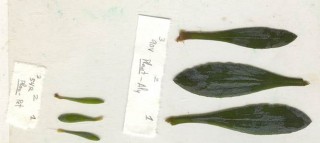
In recent years, we have embarked on several projects aimed at defining the effect of grazing on the functional structure and functional redundancy of Mediterranean herbaceous communities. This line of research has included the study of differences between grazed and abandoned areas, the analysis of different grazing intensities in interaction with production and rainfall, and the definition of the effect of different types of livestock action on the functional composition of grasslands. Our group is now expanding the scope of this research line to look at the effects of livestock farming intensification.
Ecological slope restoration
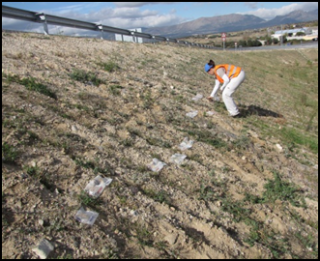 A more recent line of research concerned with ecological restoration of grasslands is looking at the role of topsoil laid on bare ground in public works restoration projects (roads, railway lines, etc.). Experiments look at the effect of the depth of the topsoil layer on the vegetation cover, soil fertility and microbial activity. The relationship between the functional traits of species often used in hydroseeding and their breakdown rates has also been studied with a view to recommending species whose necromass is rapidly absorbed by the soil and thus reduces the fire hazard. Finally, we are also doing experiments to assess the effects of topsoil storage on viable seed content in collaboration with companies involved in the sector.
A more recent line of research concerned with ecological restoration of grasslands is looking at the role of topsoil laid on bare ground in public works restoration projects (roads, railway lines, etc.). Experiments look at the effect of the depth of the topsoil layer on the vegetation cover, soil fertility and microbial activity. The relationship between the functional traits of species often used in hydroseeding and their breakdown rates has also been studied with a view to recommending species whose necromass is rapidly absorbed by the soil and thus reduces the fire hazard. Finally, we are also doing experiments to assess the effects of topsoil storage on viable seed content in collaboration with companies involved in the sector.
Some of our major projects:
CGL2014-53789-R. Respuesta de pastizales mediterráneos al Cambio Global: ecología funcional y de comunidades en gradientes de uso, productividad y clima, IP: Begoña Peco y Javier Seoane (UAM), MICINN, 2015-2018.
P2013/MAE-2719. Restauración y Conservación de los Ecosistemas Mediterráneos: Respuesta Frente al Cambio Global. REMEDINAL-3, Adrián Escudero (URJC), IP: Begoña Peco (grupo UAM), Programa de Actividades I+D entre grupos de Investigación de la CAM, 2015-2018.
CGL2011-24871. Efecto de los cambios de uso de la ganadería extensiva en la Biodiversidad y el funcionamiento de los ecosistemas Mediterráneos, IP: Begoña Peco (UAM), MICINN, 2012-2014.
S2009/AMB/1783. Restauración y Conservación de los Ecosistemas Madrileños. REMEDINAL-2, Adrián Escudero (URJC), IP: Begoña Peco (grupo UAM), Programa de Actividades I+D entre grupos de Investigación de la CAM, 2010-2014.
CENIT-2008-1016. Operación de Autopistas Seguras, Inteligentes y Sostenibles. Interacción de la autopista con los ecosistemas. Tarea 7.3: Procesos condicionantes de la vegetación herbácea en el ecosistema de carretera e implicaciones para su gestión. IP: Begoña Peco. CDTI- Ministerio de Ciencia e Innovación. 2008-2012.
079/RN08/02.1. Valoración económica de la biodiversidad y los servicios de los ecosistemas ligados a la trashumancia en la Cañada Real Conquense: implicaciones para la gestión de los agroecosistemas mediterráneos en el contexto del cambio global, IP: José A. González Novoa (UAM), Ministerio
de Medio Ambiente y Medio Rural y Marino, 2010-2011.
CCG10-UAM/AMB-5278. Vías pecuarias de la Comunidad de Madrid: Funcionamiento ecológico y escenarios futuros, IP: Francisco Martín Azcárate, DGUI (Comunidad de Madrid)-UAM 2011-2011.
CGL2007-63382. Caracteres funcionales y diversidad de pastizales en relación con el pastoreo: La dispersión y la regeneración a partir de semillas. Aproximaciones observacionales y experimentales, IP: Begoña Peco (UAM), MEC, 01/2007-12/2011.
REN2003-01562. Cambios de uso en pastizales extensivos: Pastoreo vs abandono y sus implicaciones sobre la diversidad estructural y funcional, IP: Begoña Peco, MEC, 2003-2006.
AMB99-0382. Procesos implicados en el abandono de pastizales y sus consecuencias para la diversidad, IP: Begoña Peco, MEC, 2000-2002.
